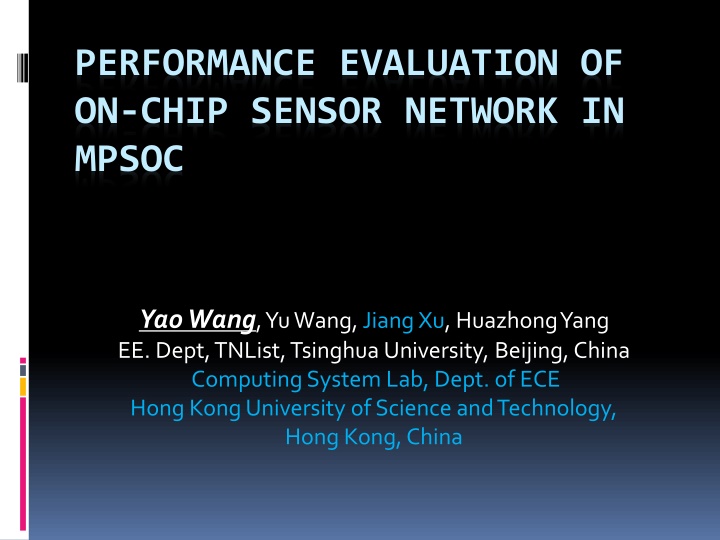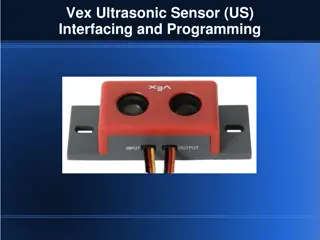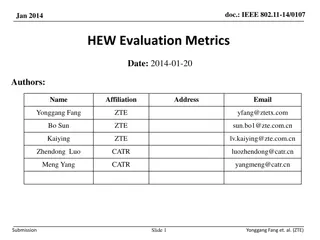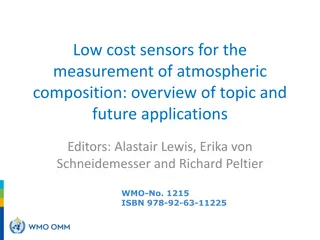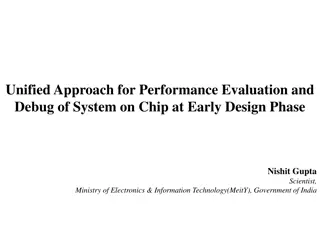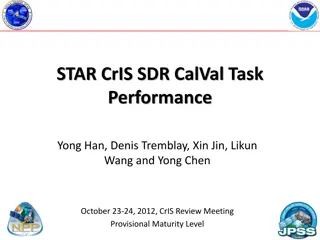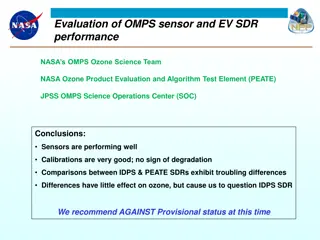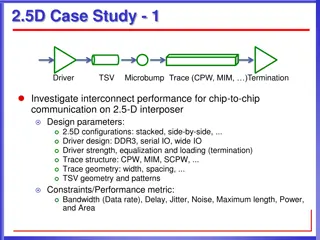Performance Evaluation of On-Chip Sensor Network in MPSoC
In this study, the performance evaluation of on-chip sensor networks in Multi-Processor System-on-Chip (MPSoC) architectures is explored. Limitations of bus interconnects are discussed, and the concept of Network-on-Chip (NoC) as a solution is introduced. The integration of sensors in MPSoC design is examined, emphasizing the importance of sensor network-on-chip (SENoC) for optimizing reliability and performance. The working flow of SENoC is outlined, showcasing how sensors collect information for analysis and decision-making processes within the system.
Download Presentation

Please find below an Image/Link to download the presentation.
The content on the website is provided AS IS for your information and personal use only. It may not be sold, licensed, or shared on other websites without obtaining consent from the author.If you encounter any issues during the download, it is possible that the publisher has removed the file from their server.
You are allowed to download the files provided on this website for personal or commercial use, subject to the condition that they are used lawfully. All files are the property of their respective owners.
The content on the website is provided AS IS for your information and personal use only. It may not be sold, licensed, or shared on other websites without obtaining consent from the author.
E N D
Presentation Transcript
PERFORMANCE EVALUATION OF ON-CHIP SENSOR NETWORK IN MPSOC Yao Wang, Yu Wang, Jiang Xu, HuazhongYang EE. Dept, TNList, TsinghuaUniversity, Beijing, China Computing System Lab, Dept. of ECE Hong Kong University of Science and Technology, Hong Kong, China
Outline Motivation An Overview of SENoC Experiments Future work Q&A
Limitations of Bus Interconnect In the past, the on-chip interconnects are mainly share-medium buses Disadvantages: Bus architecture mainly uses global synchronized circuits, which is harder to realize with the ever increasing frequency because of clock skew The performance of bus interconnect is not scalable with the number of cores. For future MPSoCwhich will integrate hundreds of cores on a single chip, bus interconnect is no longer suitable ARM AMBA Specification and Multi layer AHB Specification (rev2.0), http://www.arm.com, 2001 Architectural innovations for network on chip , VijaykrisnanNarayanan, Pennsylvania State University
Network-on-Chip (NoC) To address the disadvantages of bus architec- ture, NoCis proposed to be a solution Advantages: Avoid the clock skew problem by GALS circuits Solve the performance bottleneck by supporting multiple-to-multiple communication pattern Shorten the design time by supporting IP reuse Various topologies to fit different applications Partha Pratim Pande, etc. Performance Evaluation and Design Trade-offs for Network-on-Chip Interconnect Architectures , IEEE Transactions on Computers
Sensor Network-on-Chip (SENoC) Why sensors are employed in MPSoCdesign? 1. More PUs are integrated in MPSoC Intel predicts that within ten years processors might have tens or even thousands of cores 2. Reducing feature size brings higher variations 180nm->130nm->90nm->65nm->45nm 3. Scaling technology introduces higher power density which raises thermal problem For reliability and performance optimization concern, we need to introduce sensors into NoC.
Working Flow of SENoC Sensor collect information (Temperature\ Voltage\frequency) Sensor information is sent to a processing unit through NoC The processing unit analyze the information and then make decision The related core receives the decision and takes action The decision is sent to a related core through NoC
Related Work I Combine NoC and sensors to perform system monitoring and control. Yu Wang et al. proposed a systematic app- roach, on-chip sensor network (SENoC), to collaboratively detect, report, and alleviate run-time threats (e.g. simultaneous switch- ing noise) in MPSoC Avoid the traditional stop-go method, obtain a 26.12% performance gain Yu Wang, Jiang Xu, ShengxiHuang, Weichen Liu, HUazhongYang, A Case Study of On-Chip Sensor Network in Multiprocessor System-on-chip, in CASES 2009
Related Work II Build a sub-network to transfer only sensor info. Mudduri et al proposed a monitor subsystem called MNOC advantage: sensor info will not interfere with the regular traffic disadvantage: extra area and higher design complexity, not scalable S. Madduri, R. Vadlamani, W. Burleson, R. Tessier, A Monitor Interconnect and Support subsystem for MulticoreProcessors, in the Proceedings of the IEEE/ACM Design Antomation and Test in Europe Conference, Nice, France, April 2009.
Evaluation of SENoC While sensors provide great benefit for system reliability and performance optimization, the sensor information will occupy the bandwidth resources. To evaluate the overhead of performance loss after adding sensors, our paper develop a SENoCsimulation platform. Bandwidth Regular data Sensor data
Main Contributions of The Paper We developed a SENoCsimulation platform in systemCwhich supports cycle-accurate simulation We study the average delay of regular data and sensor data, respectively. The results show that the overhead of sensors is negligible , with a max delay overhead of 0.80% when the traffic is not that heavy We explore the influence of the sensor manger s location on the network performance
Outline Motivation An Overview of SENoC Experiments Future work Q&A
NoC Architecture 4*4 Mesh-like NoC
SENoC Architecture After adding sensors and sensor manager, the NoC becomes SENoC
Router Architecture The router routes the flit according to the routing table
Network Interface Network interface multiplex the sensor data and regular data
Switching Methodology 4 Virtual Channel, X-Y static routing Time is divided into frames, with 32 time slots formingaframe. In each frame, there are 4 transfer modes according to the status ofthe outputbuffers Traditional VC method
Switching Methodology Empty Non-empty Empty Non-empty
Outline Motivation An Overview of SENoC Experiments Future work Q&A
Simulation Setup Flit size: 32 Operating frequency: 1GHz Data Distribution: Poisson distribution ( =0.2) Buffer Size: 10 Sensors: 8/per core (For DVS application) Masters: 8 (uniform data flow) Slaves: 8
Experiments Variable Parameters 1. The location of sensor manager 2. The interval of two sensor data sampling (200, 500, 1000, 2000 cycles. Typically 3000) Performance metric Average latency of sensor data and regular data, respectively.
Experiments Results A (corner) Average Delay of Regular data 98.86 B (center) Average Delay of Regular data 98.86 C (edge) Location Cycles Between Two samples Average Delay of Sensor data N/A Average Delay of Sensor data N/A Average Delay of Regular data 98.86 Average Delay of Sensor data N/A 200 99.65 130.80 98.79 104.87 99.19 113.64 500 98.98 120.24 99.32 105.48 98.47 106.78 1000 99.10 109.03 98.80 97.23 98.91 98.73 2000 98.99 101.83 98.87 98.03 98.89 93.70 Conclusion 1: After adding sensor data, the average delay of regular data has no big change (maximum 0.80%) the sampling rates. the sensor manager in the center. Conclusion 2: The delay of the sensor data increases with Conclusion 3: Under the uniform data flow, it s best to place
Outline Motivation An Overview of SENoC Experiments Future work Q&A
Future work 1. Scalability of SENoC When the number of cores rises to 64 or 256 or even more, will our strategy be applicable? Consider following idea: 2. Placement of sensor manager Hardware: application-aware design, a design methodology to place the SM according to the communication pattern Software: Dynamically locate the SM at a place where the traffic is not heavy to alleviate contention
Outline Motivation An Overview of SENoC Experiments Future work Q&A
